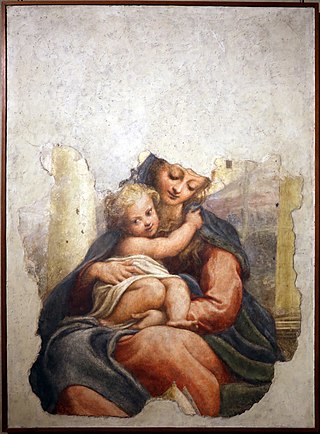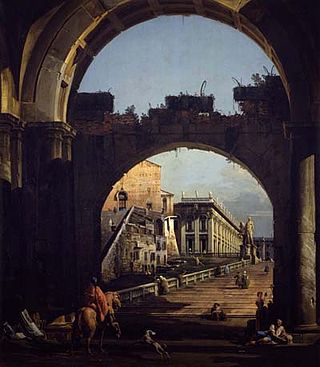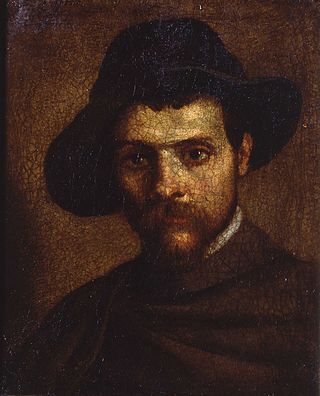
Antonio Allegri da Correggio, usually known as just Correggio was an Italian Renaissance painter who was the foremost painter of the Parma school of the High Renaissance, who was responsible for some of the most vigorous and sensuous works of the sixteenth century. In his use of dynamic composition, illusionistic perspective and dramatic foreshortening, Correggio prefigured the Baroque art of the seventeenth century and the Rococo art of the eighteenth century. He is considered a master of chiaroscuro.

Bartolomeo Schedoni was an Italian early Baroque painter from Modena.

La Scapigliata is an unfinished painting generally attributed to the Italian High Renaissance artist Leonardo da Vinci, and dated c. 1506–1508. Painted in oil, umber, and white lead pigments on a small poplar wood panel, its attribution remains controversial, with several experts attributing the work to a pupil of Leonardo. The painting has been admired for its captivating beauty, mysterious demeanor, and mastery of sfumato.

The Madonna and Child with Sts Jerome and Mary Magdalen (The Day) is an oil on canvas painting by the Italian Renaissance artist Correggio dating from around 1528 and housed in the Galleria Nazionale of Parma, Italy.

Madonna and Child is a 1621–1627 painting by Anthony van Dyck, now in the Galleria nazionale di Parma.

The Madonna and Child with Saints Michael the Archangel and Andrea is a Cima da Conegliano painting oil on panel dating from c. 1496–1498, and preserved at the Galleria nazionale di Parma.

Archangel Michael fights the devil and the Virgin of the Assumption of the Angels is an oil painting on canvas of Dosso Dossi and Battista Dossi, dated to about 1533 to 1534 and preserved at the Galleria nazionale di Parma.

The portrait of Don Philip of Bourbon Family is an oil painting on canvas of Giuseppe Baldrighi, dated to about 1757 and preserved in the Galleria Nazionale Di Parma.

The Madonna of the Stairs is a fresco fragment by the Italian Renaissance artist Correggio, dating to ca.1522–23 and now in the Galleria Nazionale di Parma.

Healing of the Man Born Blind is a c.1573 painting by El Greco, showing the healing the man blind from birth. It is now in the Galleria nazionale di Parma. It is signed at the bottom right-hand corner. It shows the artist returning to a theme he had first painted five years earlier, in a work now in Dresden.

Holy Family with the Infant Saint John the Baptist is a painting by Parmigianino, executed c. 1528. It was in the Palazzo Farnese in Rome until 1662, when it moved to Parma. There it hung in the Palazzo del Giardino and later in the Galleria Ducale - the 'Descrizione' of the latter in 1725 called it one of the finest works on display there. It and the rest of the Farnese collection were later moved to Naples and the work was exhibited for a few years in the Palazzo Reale before moving to its present home in the National Museum of Capodimonte. Two early copies remain in the Galleria Nazionale and Palazzo Comunale in Parma.

Pope Paul III with a Nephew is an unfinished 1534 oil on slate portrait by Sebastiano del Piombo, now in the Galleria nazionale di Parma. The nephew's identity is unclear but the painting's presumed date suggests it may be Ottavio Farnese, whom Pope Paul III made Duke of Parma and Piacenza soon after the work's date

Deesis with Saint Paul and Saint Catherine is an oil on panel painting by Giulio Romano, executed c. 1520, now in the Galleria nazionale di Parma. Its title refers to deesis, a subject in Christian iconography, shown here with Paul of Tarsus and Catherine of Alexandria in the lower register and the Virgin Mary and John the Baptist in the upper.

Mystic Marriage of Saint Catherine or Mystic Betrothal of Saint Catherine is a c.1524 oil on canvas painting by the Italian Renaissance painter Parmigianino. The work is now in the Galleria nazionale di Parma. Art historians argue that the work may be attributed to the period in which Parmigianino was painting his first works in the church of San Giovanni Evangelista, as also emerges from a recent restoration, which has shown that its technique is near-identical to that of Parmigianino - "no underdrawing, pigment use, descriptive speed, drafting of final shadows, using fingers and brush-ends as tools".

Portrait of a Man in a Red Beret or Self-Portrait in a Red Beret is an oil on paper painting attributed to Parmigianino or Michelangelo Anselmi, executed c. 1540, now in the collection of the National Gallery of Parma.

Capriccio with the Campidoglio is a c. 1742 oil-on-canvas painting by the Italian artist Bernardo Bellotto. It was acquired by count Stefano Sanvitale di Parma in 1835 and then exhibited in the Galleria nazionale di Parma, where it now hangs alongside another painting originally produced as its pendant.

The Funeral of the Virgin Mary is a 1605-1609 oil on canvas painting by Ludovico Carracci, now in the Galleria nazionale di Parma.

Self-Portrait is a 1593 oil on canvas painting by Annibale Carracci, now in the Galleria Nazionale di Parma. It is dated 17 April 1593 on the top left of the canvas.

Pietà with Saints Clare, Francis and Mary Magdalene is a 1585 oil on canvas painting by Annibale Carracci, now in the Galleria nazionale di Parma.



















